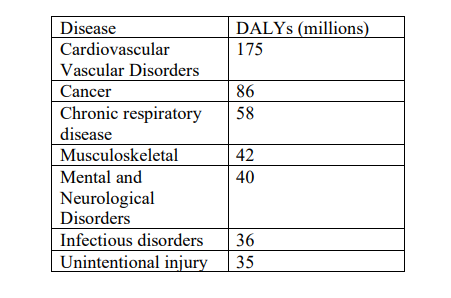Introduction
Cardiac arrest happens whenever the heart abruptly stops functioning. If the loss of blood supply to the brain is not addressed right away, an individual may lose awareness, become handicapped, or pass away. A major global risk of death is cardiac arrest outside of a hospital. Over 30 percent of all fatalities worldwide in 2019 were attributed to cardiovascular illnesses, killing approximately 18 million individuals (World Health Organization, 2021). Heart attack and stroke deaths accounted for 85% of these fatalities. In the USA, the mortality rate from cardiovascular disorders increased by 10% between 2011 and 2018 (Ritchey et al., 2019). As a result, the disease is the leading cause of death among the elderly. This situation asks for measures to be taken and an advanced engineering solution was found to address the problem.

Engineering Response
Background on Engineering Response
Loss of consciousness and variations in heart rate are two signs of cardiac arrest. Smart watches keep track of heart rates and notify the patient’s nearest relatives if they start getting dizzy. Consumers are starting to use devices to monitor their health as technological advancements become integrated into daily life. Consumer-grade linked smart wearables include smartwatches, and it is believed that 20 percent of U.S. citizens presently own one. Predictably, the worldwide market for wearable technology will reach 70 billion U.S dollars by the year 2025. An example is the Samsung Galaxy Watch 4, an older smartwatch where wearable technology was integrated. (Bin et al., 2022). The gadget calls a pre-listed emergency contact, including family members nearby, if a senior user does not respond to the alert SMS within 1 minute after collapsing.

Design Considerations
Engineering ideas for sensing devices include mobile software, activity sensors and global positioning system. Using mobile software, all essential information for activity tracking and alarms may be configured. Additionally, mobile software regulates alerts for voice calls, SMS, instant messaging, and updates from social media sites.
Activity sensors allow to measure key indicators of human health. Physical exercise is advised as a lifestyle choice to support heart health and reduce the probability of onset of cardiac events. Wearables may reliably and objectively evaluate physical exercise and energy usage through a variety of sensors. The seismic mass and gyroscope of the triaxial accelerometer are used to detect linear acceleration.
In order to provide a precise position of users and make it easy to follow them in the event of unconsciousness, wearables also integrate barometers and GPS (Bayoumy et al., 2021). The barometer can then monitor elevation variations, count stairs, and identify falls based on the idea that air pressure drops as height increases. Consumer wearables categorize heart rhythm employing algorithms and compute beat-to-beat periods to assess heartbeats by electrocardiography.
The healthcare sector uses a lot of data; thus, managing this sensitive information always comes with hazards. These contemporary technologies naturally produce more personal data, as is their nature (Mulder, 2019). Thus, maintaining privacy while developing should be a top priority. Moreover, the simplicity of use of this device should be taken into account while choosing and creating it because older people tend to utilize smartwatches.
Despite all their advantages, smartwatches also have some limitations. Thus, their battery life is limited to fewer than 48 hours, which necessitates regular charging. Moreover, smartwatches are costly and may be out of reach for low-income people. Finally, many nations do not yet allow ECG and blood pressure readings.
Conclusion
Cardiac arrest occurs when the heart suddenly stops working, especially among the aging population. If a person’s blood flow to the brain is interrupted, he or she may lose consciousness, become disabled, or die. Smartwatches monitor heart rates and alert the patient’s closest relatives if they become dizzy. Smartwatch engineering design considerations include information privacy and confidentiality, functionality and accuracy, and user-friendliness of the device.
References
Bayoumy, K., Gaber, M., Elshafeey, A., Mhaimeed, O., Dineen, E. H., Marvel, F. A., Martin, S. S., Muse, E. D., Turakhia, M. P., Tarakji, K. G., & Elshazly, M. B. (2021). Smart wearable devices in cardiovascular care: Where we are and how to move forward. Nature Reviews Cardiology, 18, 1–19. Web.
Bin, K. J., Pretto, L. R. D., Sanchez, F. B., & Battistella, L. R. (2022). A digital platform to continuously monitor patients using a smartwatch: a preliminary report. JMIR Formative Research, 6(9), e40468. Web.
Mulder, T. (2019). Health apps, their privacy policies, and the GDPR. Papers. Web.
Rajawat, D. (2021). Samsung Galaxy Watch 4 review with pros and cons – Smartprix. Smartprix Bytes. Web.
Ritchey, M. D., Wall, H. K., George, M. G., & Wright, J. S. (2019). U.S. trends in premature heart disease mortality over the past 50 years: Where do we go from here?Trends in Cardiovascular Medicine, 30(6). Web.
World Health Organization. (2021). Cardiovascular diseases (CVDs). Who. Int. Web.
Xie, Y., Bowe, B., Mokdad, A. H., Xian, H., Yan, Y., Li, T., Maddukuri, G., Tsai, C.-Y., Floyd, T., & Al-Aly, Z. (2018). Analysis of the Global Burden of Disease study highlights the global, regional, and national trends of chronic kidney disease epidemiology from 1990 to 2016. Kidney International, 94(3), 567–581. Web.